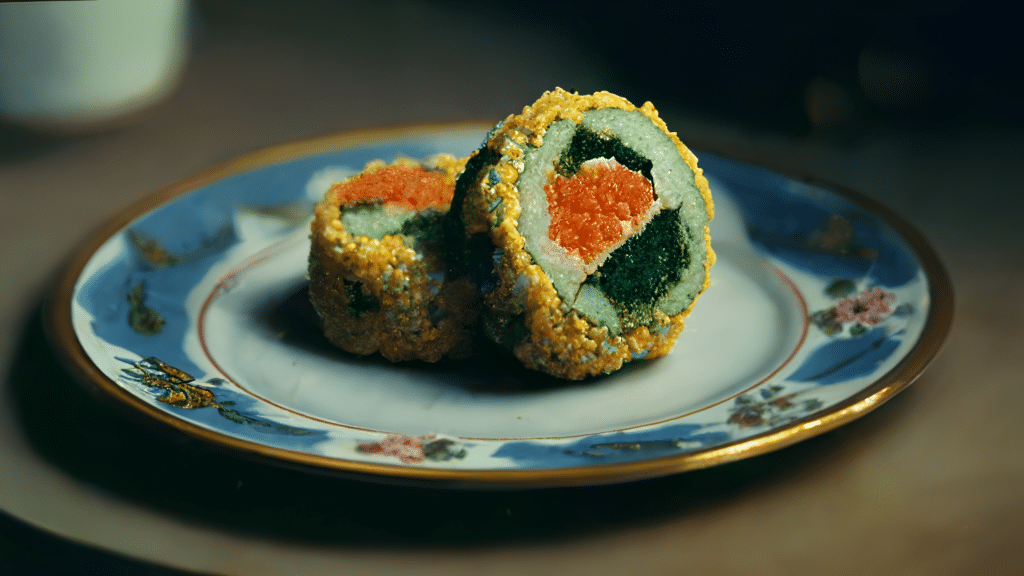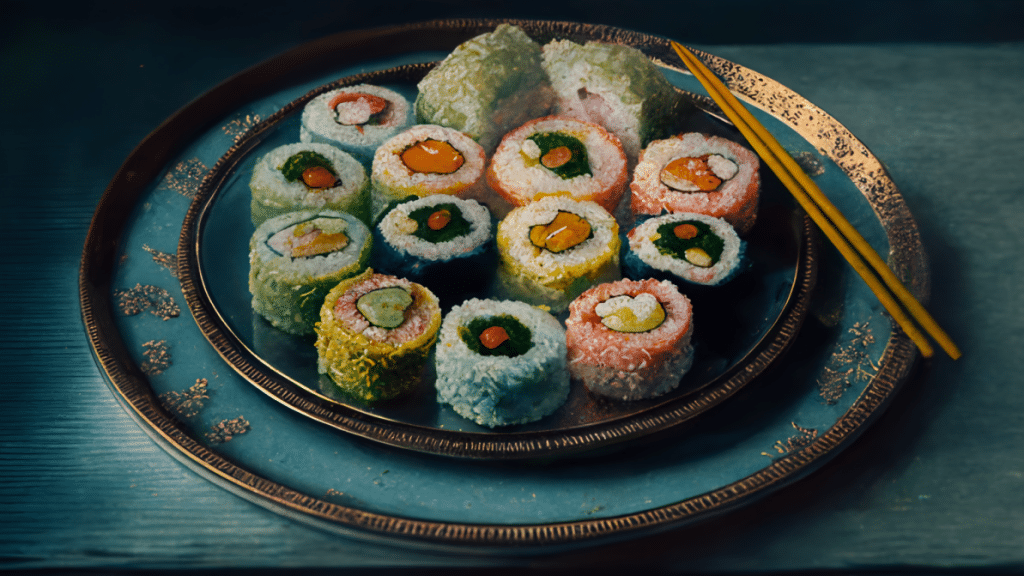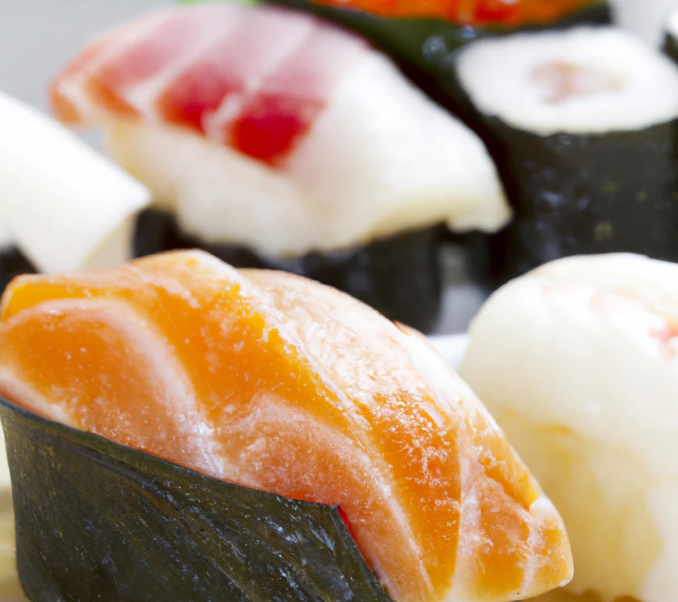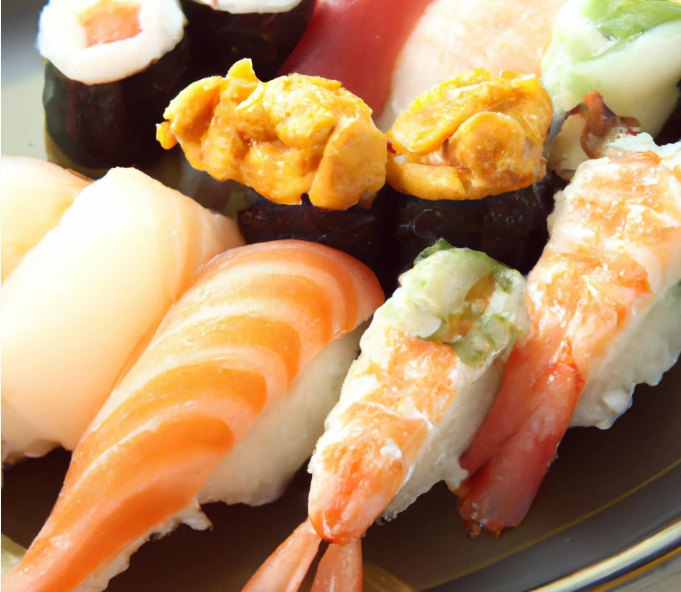If you’re like us, you love sushi – and you especially love it when it’s fried! There’s something about the combination of crunchy tempura batter and succulent fish that makes fried sushi irresistible. But did you know that there are actually several different types of fried sushi? Well, if you’re ready to explore the wonderful world of fried sushi, then you’ve come to the right place!
In this blog post, we’ll be discussing the many types of fried sushi, each with its own unique flavors and textures. We’ll also provide a few helpful tips for making your own fried sushi at home. So buckle up for a delicious adventure – it’s about to get fried and wild!
Table of Contents
Quick Recap of Key Points
Tempura is a popular type of fried sushi, where seafood or vegetables are lightly coated in a batter and deep-fried. Some restaurants also serve items like fried California rolls and deep-fried salmon skin rolls, which can also be considered types of fried sushi.
What is Fried Sushi?
Fried sushi, also referred to as tempura sushi or aburi sushi, is a unique form of the classic sushi dish. It’s created by deep-frying some of the ingredients used to create regular sushi dishes, adding a distinct crunchy texture and flavor that sets it apart. The options are both delicious and visually stunning; some of the most popular varieties include soft-shell crab, avocado, soft-shell shrimp, and miso-glazed eggplant. When it comes to discussing the merits of fried sushi, opinions tend to differ. While some believe that the introduction of deep-fried items takes away from traditional Japanese techniques and works against the idea of healthy eating habits, others find fried sushi to be an irresistibly delicious version of the traditional dish.
There is no doubt, however, that its preparation does require some modern changes not typically adopted in other forms of cooking, which makes for a fresh approach that many cherish. No matter your opinion on fried sushi, it remains one of the most beloved dishes across cultures. In this section we will explore some of the different types this scrumptious dish has to offer. With that in mind let’s move onto delving into the next section about “Types of Fried Sushi”.
Types of Fried Sushi
Fried sushi can be divided into two distinct categories – tempura-style and deep-fried. Tempura-style fried sushi is arguably the more popular type of fried sushi, made with a light batter of wheat flour, cold water, and egg. This style of sushi is quick to cook, typically fried for no more than 2 minutes per side, and as it is not cooked too long, the texture and flavor of the dish remains intact. The most common form of tempura-style fried sushi is vegetable tempura rolls. On the other hand, there is deep-fried sushi which uses a thicker batter that results in a crispier texture. Popular forms of this style include California rolls wrapped in nori (seaweed paper) before being dipped in the thick batter and deep-fried until golden brown.
Some restaurants also offer creative takes on traditional Japanese flavors such as using shrimp tempura as filling or topping with spicy mayo and eel sauce. Overall, both tempura-style and deep-fried sushi present a unique twist on traditional Japanese cuisine. However, if you are looking for a crunchy option with bold flavors, deep-fried sushi has greater potential for delivering an unforgettable eating experience. Now that we have explored different types of fried sushi, let’s take a look at one specific variant – vegetable tempura rolls – in the next section.
Vegetable Tempura Rolls
Vegetable tempura rolls are a delectable variation of fried sushi. Crispy and flavorful, veggies such as carrots, cucumbers, and avocados are wrapped in rice and seaweed, then deep-fried with a lightly golden coating of tempura batter. Vegetables provide some great nutritional benefits to sushi which may make it even healthier than traditional forms. Veggies can be low in fat and calories but high in fiber and vitamins that many people lack in their diet. Plus, they often go very well with the other ingredients in a sushi roll and can help enhance its flavors.
However, some people may prefer raw vegetables in their roll because they maintain more of their taste, texture, and nutrition. Additionally, the deep-frying process adds extra fat and calories to a dish that is traditionally eaten for lighter meals or snacks. But if you’re looking for an explosion of flavor combined with the health benefits of veggies, then vegetable tempura rolls could be the way to go. And now let’s look at another variation of fried sushi: fish tempura rolls – an exploration of unique fishy flavors!
Fish Tempura Rolls
When it comes to fried sushi, a beloved type of sushi that is just as popular as its traditional counterpart, fish tempura rolls are a must try. Fish tempura rolls combine the delicious tastes of traditional sushi ingredients with an added layer of crunch and flavor. Tempura batter is lightly fried around a roll comprising fish and rice along with any other desired ingredients for a unique texture and flavor profile. Popular fish tempura roll flavors include spicy tuna, California roll, salmon skin roll, and tuna mayo roll. Fish tempura rolls offer several advantages when compared to its traditional counterparts. For example, the light coating of crispy batter adds an interesting dimension to the dish and can act as a savory accent.
Additionally, the unique combination of textures from fried batter and crunchy vegetables or soft fish can offer an enjoyable experience for your taste buds. There are some disadvantages to consider as well however. For example, the light coating of batter adds extra calories to the meal which can be detrimental if enjoyed on a daily basis.
Moreover, if not cooked properly, the extra batter can disguise the flavors of the underlying ingredients leading to an unsatisfying dish. At the end of the day, fish tempura rolls provide a unique twist on traditional sushi that can lead to delightful experiences in terms of both flavor and texture – though proceed with caution if looking to enjoy them on a regular basis. With this in mind, let’s explore how one can make their own fried sushi creations. The next section will discuss different steps taken in order to make fried sushi at home.
●According to a survey conducted by Japanese food portal site, Gochikuru, the most popular type of fried sushi in Japan is temaki-zushi (hand-rolled sushi).
●In 2020, California rolls topped the list of most popular types of fried sushi in the US.
●Among US consumers age 18-34, ebi (shrimp) tempura rolls were the most popular type of fried sushi, according to data from Technomic’s 2019 Sushi Consumer Trend Report.
How To Make Fried Sushi
Making fried sushi requires a bit of finesse, as this process involves many layering techniques and careful consideration. The first step is to understand the difference between “regular” sushi and fried sushi. Sushi is typically composed of raw or cooked fish that is wrapped in nori seaweed, along with other ingredients like cucumber, onion, and avocado.
Fried sushi does not contain raw fish but instead uses cooked ingredients like crab meat and vegetables such as squash, zucchini, and green beans. Other common ingredients include eggs, cream cheese, tempura batter, and even panko bread crumbs. The next step is to gather all the necessary ingredients. This includes rice (typically white or brown), nori seaweed (toasted), sushi vinegar (for flavoring the rice), fillings, egg wash (two eggs beaten together), tempura batter mix (which contains flour and water) and panko bread crumbs.
The sushi roll then needs to be constructed starting with a layer of nori seaweed laid out on a tray or cutting board. The seasoned rice should then be spooned onto the coasting layer of seaweed followed by the chosen fillings being laid on top evenly. It is then important to tuck the ends of the rolls in so that everything remains securely in its place before wrapping it up tightly with both hands. Now comes the tricky part – deep-frying! For this step you need an oil that can sustain high temperatures such as Canola or vegetable oil.
Once placed into the oil heated to 370°F for about 2 minutes per side or until golden brown in color, remove from heat and dip lightly in a mixture of soy sauce and wasabi paste for added flavor before serving. Debates over whether one should make their own fried sushi at home have been around for years as some argue it’s too time consuming while others suggest it’s safer than eating at restaurants (as they don’t use heavy frying oils).
This could be a good option if one has time on their hands and would like to ensure they are using fresh ingredients while still reaping the benefits of fried sushi! Finally, after mastering fried sushi preparation one needs to consider the battering process which will determine how crispy and crunchy the outside texture will be – a topic that will be discussed in more detail in the upcoming section.
The Battering Process
The main factor that drives the deliciousness of fried sushi is the battering process. The coating on the outside of these bites vary depending on the type of fried sushi being made and can determine whether it turns out crispy, crunchy, or has a light dusting.
Generally, fried sushi will be lightly coated in flour, eggs and panko crumbs before being deep fried in oil. Depending on what type of fried sushi is being prepared, additional ingredients such as mayonnaise or cream cheese may be added to the batter for texture and flavor.
There is debate among chefs and food enthusiasts alike about whether or not adding additional ingredients to fried sushi batter is essential for making a delicious dish. Some argue that if done properly, traditional batters are all that is needed to create a delectable treat.
Others find that adding elements like mayonnaise or cream cheese creates an aspect of creaminess that cannot be achieved with just the flour, egg and panko combination. Ultimately, it comes down to personal preference; some recipes call for additional ingredients while others are minimalist. Now that we have explored the battering process behind fried sushi let’s move onto exploring some popular recipes.
Popular Fried Sushi Recipes
When it comes to fried sushi recipes, there is no shortage of delicious options. From classic California rolls to shrimp tempura rolls, each type of fried sushi can be prepared in a variety of ways to satisfy every taste bud. Some popular recipes include: California Rolls – Usually made with crab meat, avocado and cucumber, California rolls can be rolled up into a sushi roll and then deep-fried until golden brown. Shrimp Tempura Roll – A seafood favorite, shrimp tempura rolls are made with battered shrimp, carrots and cucumber.
The whole roll is then lightly fried in a skillet or deep-fryer. Spicy Tuna Roll – Spicy tuna rolls are created with spicy quick-cooking tuna and crunchy vegetables like celery and cucumber. They are then rolled up into a sushi roll and flash fried for a few seconds. Tako (Octopus) Onigiri – Tako onigiri is traditionally a triangular rice ball stuffed with octopus miso paste and then lightly fried for flavor. Choosing which type of fried sushi recipe you want to make depends on personal preference and diet.
Deep frying generally adds more fat and calories to the dish while flash frying takes less time but has more intense flavors. Every individual should weigh the pros and cons when deciding which technique they prefer. After exploring an array of popular fried sushi recipes, it is time to focus on how they should be served. In the next section, we will discuss some great serving suggestions for fried sushi that are sure to please everyone at your next gathering.
Serving Suggestions for Fried Sushi
Serving suggestions for Fried Sushi are endless and can quickly turn from a simple appetizer to an elaborate main course. As fry technique varies, so do the flavors and presentation, which can be both aesthetically appealing and enjoyable for the palate. Some of the more popular accompaniments for this crisp and delicious dish include world-spanning garnishes such as salsas, hot sauces, and dipping sauces. Additionally, there is also the traditional pairing of soy sauce and pickled ginger to offer a delectable contrast in flavors.
It’s key to note that not every serving suggestion needs to be exotic or complicated; sometimes simpler is the way to go. For example, fried sushi pairs well with wasabi mayonnaise and lemon or lime slices to give a bright accent; while fresh herbs like parsley or chives add vivid color. Also, adding a dollop of crème fraiche brings an elegant addition to your plate.
However, some purists believe that serving suggestions with fried sushi should remain minimalistic as it takes away from the natural flavor of the dish. They point out that keeping the food plain allows you to enjoy all its nuances without any added layer of complexity. Thus making it up to the individual eater on whether they wish to have a side accompaniment or none at all. No matter what style of service one chooses for fried sushi, the final platter should be memorable—capturing all five senses in one harmonious bite. Now that we have explored some creative serving suggestions for fried sushi, let’s move onto our final thoughts on this delectable delicacy in the next section.
Final Thoughts on Fried Sushi
The deliciously fried world of sushi offers a unique culinary experience for both sushi purists and those who may be on the fence about this classic Japanese dish.
Fried sushi is a great vehicle for introducing new flavors to the traditional tuna or salmon rolls. And though some may see it as a slight departure from the usual fare, fried sushi can bring out a whole new palette of flavors and satisfaction. Though there are some who contend that the authentic method of rolling sushi should not be exposed to heat, others argue that frying adds much-needed texture and savoriness to the fish and vegetables used in traditional raw fish rolls.
Not only can fried sushi offer a more complete realm of flavor than raw varieties, but it can also provide a much more unique visual presentation, as well. The various crunchy bits in tempura sushi, for example, gives that particular roll much more texture and visual interest than any plain ol’ California roll.
Ultimately, the decision of whether or not to indulge in fried sushi falls upon each individual. Whether you choose to experiment with this delightful approach to the classic art form or remain content with cold rolls is completely up to you. Either way, there’s no denying that fried sushi is a delicious experience, one worth exploring and savoring for yourself.
Answers to Frequently Asked Questions with Explanations
What are the health benefits of eating fried sushi?
Eating fried sushi can have some notable health benefits. The oils used to fry the sushi usually contain beneficial fatty acids, such as Omega-3s, which are important for promoting cardiovascular health. Also, because fried sushi is generally cooked at high temperatures, it destroys any dangerous bacteria that may be present.
This makes fried sushi a great choice for those who may be worried about potential foodborne illnesses. Finally, since fried sushi is cooked in oil, it can provide help in absorbing fat-soluble vitamins and minerals, like vitamin A and iron, which can be found in the vegetables and fish used to make the sushi. In addition to these health benefits, fried sushi also provides an enjoyable taste experience not found in other types of sushi.
What ingredients are used to fry sushi?
When it comes to frying sushi, there are many different ingredients used to achieve the flavorful and crispy result. Generally speaking, when frying sushi, you’ll need some sort of oil or fat for cooking, like vegetable or canola oil, coconut oil, sesame oil, or even butter. You’ll also need some coating components such as panko bread crumbs, tempura batter mix, or cornstarch to give the sushi a crunchy texture. Additionally, your fryer will need to be pre-heated to the correct temperature to ensure proper cooking. Lastly, depending on the type of fried sushi you’re making, additional ingredients such as vegetables, fish, seasonings, sauces, and more can vary.
What are the most popular types of fried sushi?
The most popular types of fried sushi are tempura rolls, which consist of seafood or vegetables coated in a light batter and fried until golden; karaage rolls, which have battered and fried ingredients such as chicken, shrimp, and fish deep-fried in oil; and cream cheese rolls, which contain cream cheese mixed with fillings such as salmon, avocado, or tuna. Tempura rolls tend to be the go-to choice for many people because of their light flavor, while karaage rolls offer a more savory option. Cream cheese rolls are unique because of their rich and creamy texture. All three types are equally delicious and enjoyable!
What is the origin of fried sushi rolls?
The origin of fried sushi rolls is unclear, however they appear to have first appeared in the late 19th century. Based on records from a popular Tokyo restaurant, it seems that specialty fried rolls were served as early as 1893. The original style of fried rolls may have been inspired by Osaka-style tempura sushi, which was introduced to Tokyo around 1886.
The earliest Japanese cookbooks to include recipes for fried sushi rolls date back to the early 20th century. These recipes replaced traditional vinegar rice with a type of batter made from either wheat flour or rice flour, making it more suitable for deep-frying. By the mid-1900s, these fried sushi rolls had become popular throughout Japan, with variations featuring ingredients like shrimp tempura and cheese becoming particularly popular. Today, fried sushi rolls are still enjoyed in Japan and around the world. It is now rare to find Tokyo-style tempura sushi because deep-fried versions are far more convenient and popular in modern cuisine. This dish has evolved over time and chefs continue to experiment with flavour combinations and presentation styles to make this delicious food even more delicious!
Are all types of sushi suitable for frying?
No, not all types of sushi are suitable for frying. While fried sushi is a popular and delicious type of sushi, some kinds of sushi have ingredients that will not withstand the heat of cooking. For example, rolls made with seaweed contain salt and are more likely to be too delicate when fried. Furthermore, traditional nigiri-style sushi with raw fish would lose its flavor and texture if it was fried. Lastly, rolls containing mayonnaise or other sauces are not suitable to fry either since they can quickly become soggy.






